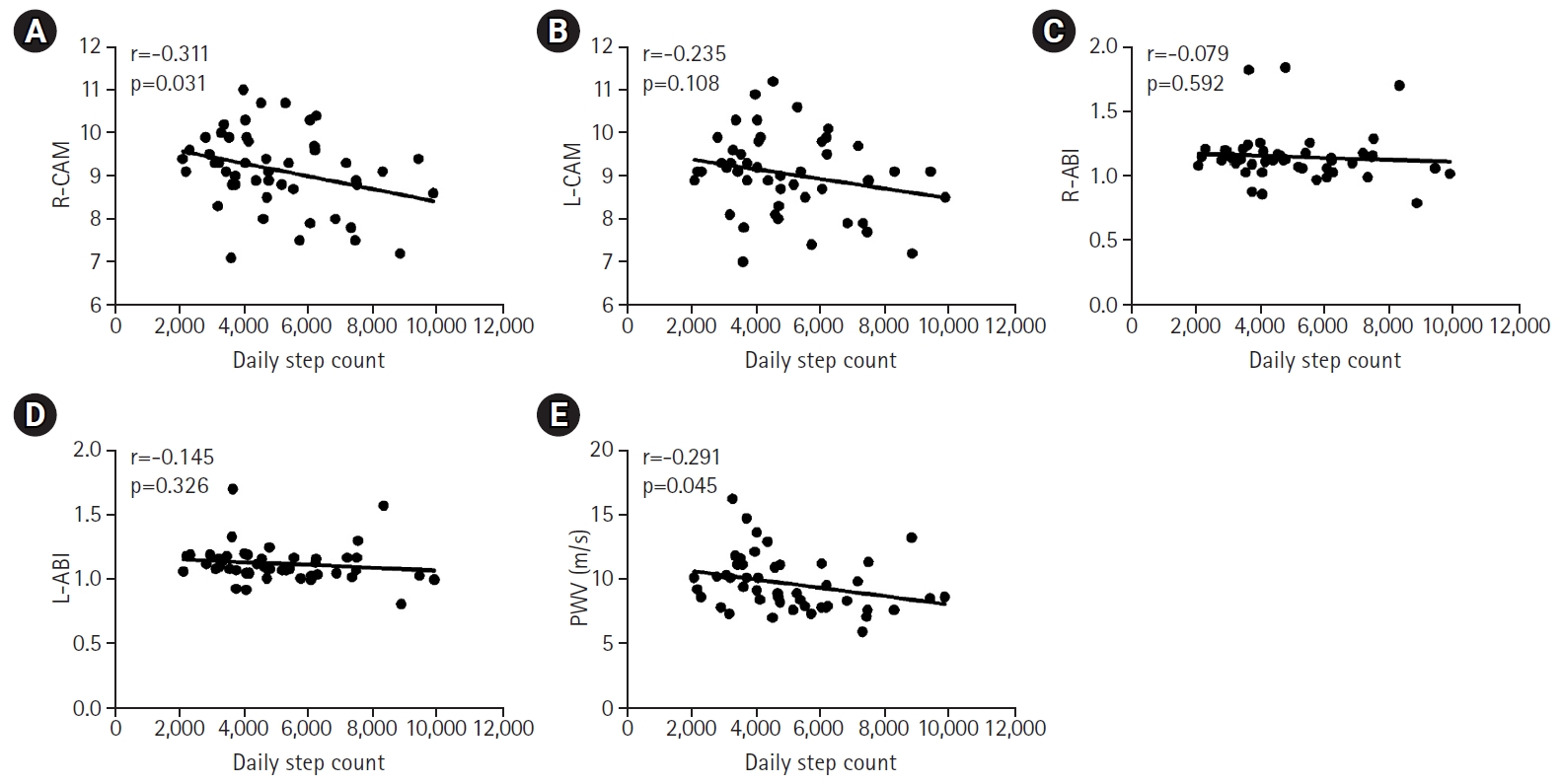 |
 |
- Search
| Ann Geriatr Med Res > Volume 28(1); 2024 > Article |
|
Abstract
Background
Methods
ACKNOWLEDGMENTS
Fig.ô 1.

Tableô 1.
| Variable | Total (n=48) | Group 1 (<5,000 steps/day) (n=28) | Group 2 (5,000ã9,999 steps/day) (n=20) | p-value |
|---|---|---|---|---|
| Physical characteristics | ||||
| ãAge (y) | 66.06ôÝ4.764 | 65.571ôÝ4.917 | 66.750+4.575 | 0.404 |
| ãSex, male | 4 (8.3) | 3 (10.7) | 1 (5) | 0.442 |
| ãHeight (cm) | 155.58ôÝ4.959 | 154.750ôÝ5.720 | 156.750ôÝ3.447 | 0.171 |
| ãWeight (kg) | 57.70ôÝ7.189 | 57.150ôÝ6.558 | 58.470ôÝ8.103 | 0.536 |
| ãBMI (kg/m2) | 24.096ôÝ2.788 | 24.124ôÝ2.236 | 24.060ôÝ3.483 | 0.938 |
| ãDaily step count | 4,645 (2,099ã9,876) | 3,678 (2,099ã4,771) | 6,548 (5,173ã9,876) | <0.001* |
| Hemodynamic parameters | ||||
| ãResting HR (beats/min) | 72.250ôÝ8.009 | 72.750ôÝ7.863 | 71.550ôÝ8.363 | 0.614 |
| ãSBP (mmHg) | 132 (94ã172) | 132 (103ã172) | 127 (94ã139) | 0.026* |
| ãDBP (mmHg) | 75.771ôÝ10.199 | 77.393ôÝ10.792 | 73.500ôÝ9.082 | 0.195 |
| ãPP (mmHg) | 53.188ôÝ11.409 | 55.786ôÝ12.583 | 49.550ôÝ8.550 | 0.061 |
| ãMAP (mmHg) | 93.500ôÝ10.687 | 95.988ôÝ10.621 | 90.017ôÝ10.015 | 0.055 |
| Biochemical parameters | ||||
| ãTC (mg/dL) | 234.063ôÝ45.237 | 234.571ôÝ47.307 | 233.350ôÝ43.370 | 0.928 |
| ãHDL-C (mg/dL) | 61.917ôÝ15.643 | 57.679ôÝ13.617 | 67.850ôÝ16.684 | 0.025* |
| ãTG (mg/dL) | 85 (30ã268) | 87 (49ã268) | 85 (30ã190) | 0.691 |
| ãLDL-C (mg/dL) | 161.006ôÝ43.186 | 161.621ôÝ45.516 | 160.145ôÝ40.843 | 0.909 |
| ãFBG (mg/dL) | 98.50 (85ã243) | 97.50 (85ã130) | 102.50 (87ã243) | 0.205 |
| Clinical parameters | ||||
| ãHT | 12 (25) | 11 (39.3) | 1 (5) | 0.007* |
| ãObesity | 17 (35.4) | 9 (32.1) | 8 (40) | 0.398 |
| ãDyslipidemia | 30 (62.5) | 19 (67.9) | 11 (55.0) | 0.272 |
| ãDM | 1 (2.1) | 0 (0) | 1 (5) | 0.417 |
Values are presented as meanôÝstandard deviation or number (%) or median (interquartile range).
BMI, body mass index; HR, heart rate; SBP, systolic blood pressure; DBP, diastolic blood pressure; PP, pulse pressure; MAP, mean arterial pressure; TC, total cholesterol; HDL-C, high-density lipoprotein cholesterol; TG, triglyceride; LDL-C, low-density lipoprotein cholesterol; FBG, fasting blood glucose; HT, hypertension; DM, diabetes mellitus.
Tableô 2.
| Variable | Total (n=48) | Group 1 (<5,000 steps/day) (n=28) | Group 2 (5,000ã9,999 steps/day) (n=20) | p-value |
|---|---|---|---|---|
| R-CAVI | 9.137ôÝ0.914 | 9.325ôÝ0.812 | 8.875ôÝ1.004 | 0.093 |
| L-CAVI | 9.041ôÝ0.925 | 9.168ôÝ0.922 | 8.865ôÝ0.923 | 0.268 |
| CAVI >0.9 | 30 (62.5) | 21 (75.0) | 9 (45.0) | 0.035* |
| R-ABI | 1.130 (0.790ã1.840) | 1.130 (0.860ã1.840) | 1.085 (0.790ã1.700) | 0.152 |
| L-ABI | 1.100 (0.820ã1.710) | 1.130 (0.930ã1.710) | 1.080 (0.820ã1.580) | 0.064 |
| ABI <0.9 | 3 (6.3) | 2 (7.1) | 1 (5.0) | 0.627 |
| PWV (m/s) | 9.639ôÝ2.149 | 10.375ôÝ2.166 | 8.610ôÝ1.689 | 0.004* |
| PWV ãË10 | 20 (41.7) | 17 (60.7) | 3 (15.0) | 0.002* |
Tableô 3.
| Variable | Correlation (r) | p-value |
|---|---|---|
| Physical characteristics | ||
| ãAge (y) | 0.197 | 0.181 |
| ãHeight (cm) | 0.129 | 0.380 |
| ãWeight (kg) | 0.004 | 0.981 |
| ãBMI (kg/m2) | -0.200 | 0.892 |
| Hemodynamic parameters | ||
| ãResting HR (beats/min) | 0.039 | 0.790 |
| ãSBP (mmHg) | -0.263 | 0.071 |
| ãDBP (mmHg) | -0.151 | 0.306 |
| ãPP (mmHg) | -0.208 | 0.156 |
| ãMAP (mmHg) | -0.218 | 0.137 |
| Biochemical parameters | ||
| ãTC (mg/dL) | 0.095 | 0.522 |
| ãHDL-C (mg/dL) | 0.316 | 0.029* |
| ãTG (mg/dL) | -0.700 | 0.638 |
| ãLDL-C (mg/dL) | 0.085 | 0.566 |
| ãFBG (mg/dL) | 0.051 | 0.732 |
BMI, body mass index; HR, heart rate; SBP, systolic blood pressure; DBP, diastolic blood pressure; PP, pulse pressure; MAP, mean arterial pressure; TC, total cholesterol; HDL-C, high-density lipoprotein cholesterol; TG, triglyceride; LDL-C, low-density lipoprotein cholesterol; FBG, fasting blood glucose.
Tableô 4.
| Variable |
Unstandardized coefficients |
Standardized coefficients |
t | p-value | VIF | |
|---|---|---|---|---|---|---|
| B (95% CI) | SE | öý | ||||
| (constant) | 14751.588 (7597.277ã21905.898) | 3545.104 | - | 4.161 | <0.001* | - |
| R-CAVI | -1427.211 (-3042.770ã188.347) | 800.542 | -0.679 | -1.783 | 0.082 | 7.796 |
| L-CAVI | 907.471 (-694.244ã2509.186) | 793.682 | 0.436 | 1.143 | 0.259 | 7.836 |
| R-ABI | 1197.946 (-4648.968ã7044.859) | 2897.263 | 0.121 | 0.413 | 0.681 | 4.607 |
| L-ABI | -3329.470 (-11083.871ã4424.932) | 3842.462 | -0.249 | -0.866 | 0.391 | 4.433 |
| PWV | -259.509 (-515.049ã-3.968) | 126.625 | -0.290 | -2.049 | 0.047* | 1.077 |
Models were adjusted for adjusted for age, body mass index, sex, blood pressure, and lipid profile.
R-CAVI, right cardio-ankle vascular index; L-CAVI, left cardio-ankle vascular index; R-ABI, right ankle-brachial index; L-ABI, left ankle-brachial index; PWV, pulse wave velocity; B, estimate; öý, standardized estimate; SE, standard error; CI, confidence interval; VIF, variation inflation factor.
Dependent variable was daily step counts (R=0.468; Adjusted R2=0.126; R2 change=0.219).
REFERENCES
- TOOLS
-
METRICS

-
- 0 Crossref
- 0 Scopus
- 728 View
- 63 Download
-
Related articles in
Ann Geriatr Med Res -
Life Course Approach on Health Disparities in Older Adults2013 September;17(3)
Association Between Arterial Stiffness and Carotid Atherosclerosis in the Elderly2005 December;9(4)






